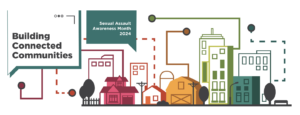Nurturing Connections, Preventing Violence: The Aligned Visions of April’s Awareness Campaigns

April brings two awareness campaigns that shine a light on interrelated issues – Child Abuse Prevention (CAP) Month and Sexual Assault Awareness Month (SAAM). While these forms of violence can be distinct, they are also deeply interconnected through the exploitation of power imbalances, systemic factors, and the normalization of harm within communities and society.
The theme for this year’s Child Abuse Prevention Month, an initiative led by Prevent Child Abuse America, is “Building a Hopeful Future, Together” which focuses on “creating a nurturing and supportive environment for children and families across the nation.” According to their website, Prevent Child Abuse America believes “in the power of prevention and the strength of community support.” They are dedicated to fostering environments where every child can grow in safety, stability, and nurturing care and their mission is to confront the systemic barriers and societal roots undermining health and well-being – poverty, racism, and other forms of marginalization.
The National Sexual Violence Resource Center’s SAAM campaign, “Building Connected Communities,” shares several key similarities with the CAP month theme:

- Community and societal level prevention strategies: Both campaigns emphasize the need to address the broader social and structural factors that enable sexual violence and child abuse, beyond just individual behaviors. This includes confronting systemic issues like racism, sexism, poverty, lack of education/opportunity, and other forms of oppression.
- Community cohesion and interconnectedness: Both campaigns emphasize that how we are all part of overlapping communities (neighborhoods, workplaces, online spaces etc.) and our actions impact each other. Strong communities with a sense of collective responsibility are key to prevention. Connected communities provide stability and nurturing environments for all.
- Health equity as a goal: Preventing sexual violence and child abuse are framed as part of the larger pursuit of health equity – ensuring everyone has fair opportunities to achieve well-being regardless of identity.
- Power of language and framing of the issue: Both recognize the importance of how we discuss and frame issues around sexual violence and child abuse, as language shapes attitudes, impacts survivors, and either perpetuates or dismantles harmful norms.
- Taking caring actions: There is an emphasis on communities actively “looking out for one another”, making caring choices, and taking steps to promote safety and respect for all members. It’s about moving beyond passive awareness and practicing empathy and mutual care.
In essence, both the CAP month and SAAM themes frame sexual violence and child abuse not just as isolated issues, but as inextricably linked to broader social determinants of health and well-being. Building strong, connected communities committed to equity is critical to uprooting the systemic conditions that enable sexual violence and child abuse, as well as other forms of harm.
Learn more about the shared risk and protective factors between multiple forms of violence including sexual violence and child abuse here.
